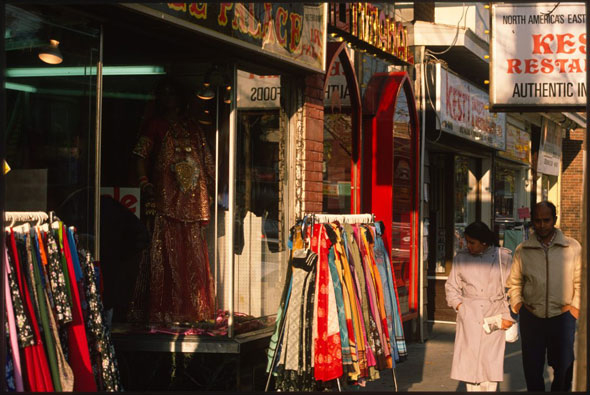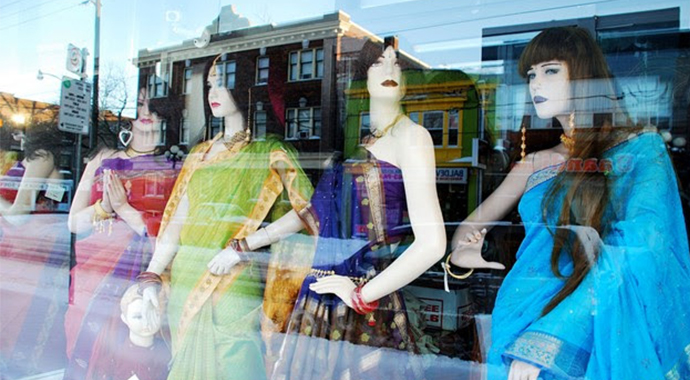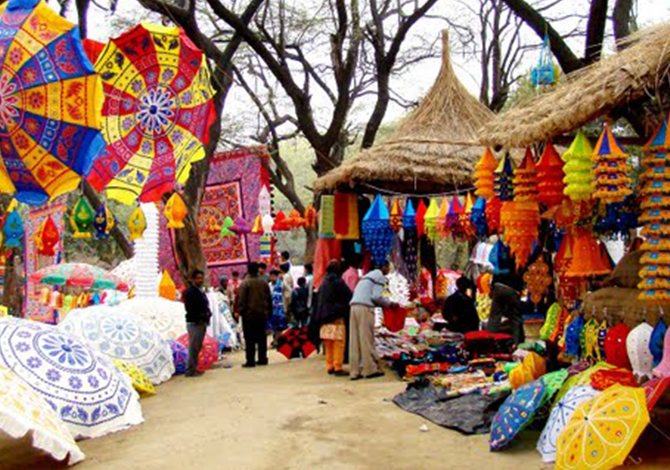The October 2015 opening of the Victoria & Albert Museum’s exhibit ‘The Fabric of India’ – a retrospective celebrating the country’s layered heritage – held all promise to reflect the breadth and depth of our traditional and contemporary textiles.
In attendance, besides museum stakeholders and the contributing fashion and craft industry contingents, was a segment of London society with ties or an interest in art, design and India’s aesthetics. As appearances go, aesthetics, while not ignored, were telling. In a sea of synthetic bandhani, machined acrylic mirror potli bags and clichéd bright colours it was evident that this interest, though significant, appeared to be lacking access to a more current Indian design aesthetic.
Obscured by distance and fed largely by what filters through Bollywood, it appears the more recent wave of design thinking emerging from India – one that puts forth textiles and the intricacies of the weave as a key design element, embraces a nuanced colour palette and provenance for the handmade – is likely going unnoticed by its own who live on foreign shores.
This same geography has Indians overseas uniquely placed to represent the country in international circles; yet, with fashion specifically, when dress isn’t reflective of a culture that is thriving or innovating, the disservice is on both ends.
The opportunity for Indian designers to cater to Indians beyond our borders is unquestionable: 25 million strong, the Indian diaspora is the largest in the world and evenly spread across East Asia, the Middle East, South and Eastern Africa, Europe, North America, Australia, the northern part of South America and the Caribbean Islands1. Comprising people of Indian origin as well as Indian nationals living abroad, it is a successful migrant population with impressive statistics.
Take for instance that at least 150,000 Indian millionaires live outside of India2 and nearly 5,000 Non-Resident Indians (NRIs) have a net worth over USD 30 million3. While not a homogenous group, and instead affected by diverse socioeconomic, historic, ethnic and religious experiences, broadly speaking, the overseas community’s relevance is economically strategic; wealth, superior education prospects and influential positions are often attributed to them.
Culturally, it is something between observation and supposition that NRIs are more traditional than their counterparts in India. Many Indians who immigrated in the 70s and 80s have brought up their children with values they experienced in India during that time. Although India has changed at lightning speed since, NRIs who didn’t go back and forth much were connected vicariously through Bollywood films and the likes of Stardust magazine from their local Indian shop. Since the mid-90s, satellite TV, the internet, social media and cheaper airfare have been phenomenal in closing this gap but somehow Indian fashion has slipped through the cracks.
Clothing from India that isn’t occasion-specific is practically a non-starter. Relegated to special events, South Asian community galas, weddings and religious functions, blouse cuts and colour combinations for occasion wear tend to be typical, while fusion wear and evening gown silhouettes with traditional Indian embroidery are particularly popular.
Until less than a decade ago, an NRI would be hard pressed to name Indian designers, most would struggle beyond Satya Paul and Ritu Kumar. Ask now, and not much has changed save perhaps the addition of Sabyasachi Mukherjee and Manish Malhotra.
The degree of one’s familiarity with Indian fashion determines whether they see their local ‘Little India’ clothing offerings for the travesties they are. Often filled with heavily marked-up stock and with a dated curatorial eye, many suspect this and prefer to make purchases during infrequent trips “home”, which is especially true for trousseau shopping. Regardless of intention, this undertaking (aside from a holy mission to Fabindia) is almost entirely dependent on a relative. Perhaps one reason a rounded perception hasn’t translated is because aesthetics often develop based on someone else’s point of view and ease of access; and are rarely discovered or cultivated by what one truly loves.

Above: Toronto’s ‘Little India’ in the 70s/80s. Image | City of Toronto Archives, Series 1465, File 383, Item 5
E-commerce, in the last decade, has brought relief and convenience if at a premium through a few scant sites like Pernia’s Pop-Up Shop, Exclusively.com and Luxemi.com. In a sense, the influx of new aesthetics in retail has circumvented the physical and shot straight to digital. This is an opportunity to be progressive but often heavy fabrication, overt embellishment and predictable colour palettes still appear to be required categories – with one founder noting client needs surpass their own desire to stock a different aesthetic.
What remains archaic is the attitude to cost. New Orleans-based Swati Narra, founder of Luxemi, an online website to buy or rent Indian fashion, explains: “NRIs who go to India expect the prices to be the same as when they grew up there. They are shocked at price tags based on ‘what you used to get for your money’. Even in the last 15 years, as pricing has changed dramatically, we are constantly battling the notion that items should be cheaper than they actually are.”
Along with the preconceived belief that India is a bargain runs the actually prohibitive realities of export pricing. Designers looking to retail internationally would need to combat these over time with economies of scale and educative marketing. For the moment, the landscape isn’t lush. Manjot Bains, a Vancouver-based writer and co-founder of the South Asian lifestyle magazine Jugni Style, says: “There are several Indian markets and boutiques in Canada that sell fabric, borders, lace, ready-to-wear, bridal, jewellery and shoes from India. There are also many tailors who have set up shop here, so getting something custom made is possible although we don’t have access to embroidery.
That said, I don’t find that the options match my personal taste, and the pricing is often much higher than what you’d spend in India. Designer knockoffs – Sabyasachi, Anita Dongre, Manish Malhotra – often retail here for the same price, or close to the original in India! Shopping on Indian sites online, I end up paying so much extra on shipping costs, added duty and Canadian taxes levied here, plus conversion from Indian Rupee to USD to Canadian dollars. It adds up to double the listed price, which is a major deterrent.”
However, there are instances of digital driving change that closely aligns with India’s and Narra notes that handloom saris are all the rage now in India and the US – a fact she attributes 100% to the internet. “They might have been seen as old fashioned before, but with all the attention on reviving and celebrating craftsmanship in India there’s a trickle down effect that we are seeing here in the US far more quickly than ever before.”
Where this leaves us is a resonance that an interest (among the interested) has been secured, and that the internet along with social media could be powerful drivers in creating direct routes to the NRI customer. A straightforward conclusion that Indian designers – if they weren’t content with servicing the growing domestic market – could be aggressively pursuing. To not tap into an audience that is able, willing and deserving of a more current aesthetic strikes as an opportunity missed – but ready for the taking.
_____________________
1 Ministry Of Overseas Indian Affairs Annual Report 2014-15
2 Capgemini Asia Pacific Wealth Report 2007
3 Wealth-X 2011





I accompanied an nri friend as she shopped last year. she wanted to have nothing to do with cotton since she would have to iron it 🙂
and nothing to do with dull colours since they wore indian clothes for festive occasions. what she chose to buy would be far from what my indian friends would define as classy or aesthetically pleasing.
needless to say the experience was pretty amusing.
Very relevant article. We face this situation often, where an nri does not understand the value of the product even if they like it aesthetically. most of them are still living in the past and feel that india could never be so expensive..
A truly perceptive and wonderfully written article. Couldn’t agree more with suniti, going by my own experience from our vast nri family and now living in the us for past 3 years.
Couldn’t agree more. The ‘dhinchaak’ aesthetic promoted by little india shops and bored housewives has to go! Waiting eagerly for heirlooms and handlooms to thrive in my fellow NRI’s closets. That might only happen if Karan Johar picks ANAVILA or RAW MANGO in lieu of Manish or Sabya for his next project 🙂
Mauritian of indian origin living in canada, Montréal. I have recently shopped online for all my indian bridal wear and i can confirm that we pay a higher price with all the currency conversions and taxes! Hopefully things will change eventually. I am a sari lover and like to experiment with different Fabrics – My personal favorite remains the handloom for its minimalism & vintage feel. Keep up the great work guys! 🙂